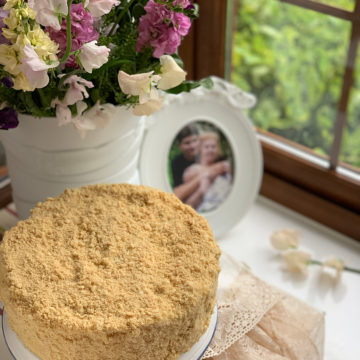
| Odessa Napoleon cake |
Cuisine: Odessa
Author: Maria Kalenska
Prep time: 15 hrs 30 mins
Cook time: 30 mins
Total time: 16 hrs
Ingredients
- 450 g flour
- 200 g cold butter
- 200 ml sour cream
- ½ tbsp vinegar
- 150 ml water
- For the cream:
- 7 yolks
- 9 tbsp flour
- 1.35 litre warm water
- 1½ cans condensed milk
- 4 tbsp sugar
- 450 g butter, room temperature
- zest of 4 large lemons
- seeds of 1 vanilla bean or 1 tsp vanilla paste
- ¼ tsp salt
Cooking method
- Sift flour. Coarsly grate the butter.
- Mixing dough by hand: In a large bowl, rub the flour and butter together with your fingertips until the mixture looks like breadcrumbs. Add sour cream, vinegar, and water, and knead the dough. The dough should be soft and not stick to your hands. If the dough sticks, add a little more flour.
- Mixing dough with a stand mixer: Pour flour into a mixer bowl, add grated butter, sour cream, vinegar, pour in water and knead the dough. The dough should be soft and easily come off the hook of the mixer.
- Sprinkle the work surface with flour, put in the dough and divide it into 8 equal parts. Wrap each piece of dough in cling film and refrigerate for 2-3 hours. ⠀
- Cook the cream. Add salt to the yolks. In a bowl, whisk the yolks with the flour until smooth. Pour warm water into a saucepan, add condensed milk and sugar. Stir until the condensed milk and sugar are dissolved. Take 300ml of this mixture, pour into a bowl with yolks and stir until smooth. Make sure there are no lumps. Put a saucepan with water and condensed milk on low heat, and warm to about 40°C. Slowly pour in the mixture with the yolks, stirring vigorously. Cook the cream, stirring constantly, until it thickens. The consistency of the cream should resemble thick sour cream. Leave to cool for 1 hour. When the cream has cooled down, but is still warm, add to the cream lemon zest, vanilla and, while continuing stirring, add soft butter in small pieces. Stir the cream until the consistency is smooth. Set aside to cool.
- Heat the oven to 180°C. Sprinkle the work surface with flour. Roll out a round cake layer approximately 2-3 mm thick. The diameter of the cake should be larger than the diameter of the springform tin. Transfer the cake to a baking sheet. Use a fork to prick the entire surface of the dough. Bake for 8-10 minutes. Transfer the cake to a plate to cool. Repeat the process for each part of the dough.
- Wrap the bottom of the springform tin with foil. Assemble the mould. Using kitchen scissors, trim the first cake layer so that it fits into the springform tin. Collect the remaining bits from the cake in a bowl. Then put a layer of cream on the cake. Cut off the second cake layer and place in a mould on top of the cream, and press down lightly. Repeat the process so that the last layer is the cream. Leave the cake to sit at room temperature for 6 hours. Then refrigerate for 2-3 hours.
- Use a blender or manually chop the remaining bits from the cake. Take out the cake from the springform tin: carefully remove the detachable part, then unfold the foil, remove the cake from the bottom of the mould and put it on a dish so that the foil remains in your hands. Sprinkle the cake with crumbs on all sides and refrigerate for 1 hour or overnight.
My tips and tricks
The secrets that my grandmother didn’t tell anyone were the nuances of how to assemble the cake so that it was perfectly shaped and its edges soaked well. And, of course, she added lemon zest to the cream, which is very unusual for Napoleon cake. You know, in Odessa cuisine, as in French, “the devil is in the details” and small nuances can radically change the taste and look of a dish, make it unlike any other person's dish. That is why, for all the holidays in our family, the unique grandmother's Odessa Napoleon was the perfect finale of the rich dinner.
Maria Kalenska Gastronomy Blog | http://www.myodessacuisine.com/recipes/odessa-napoleon-cake/